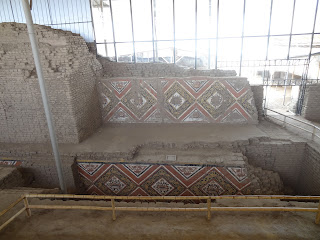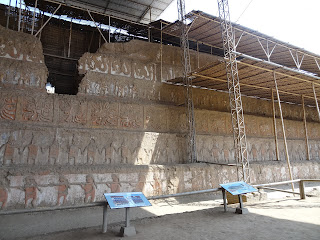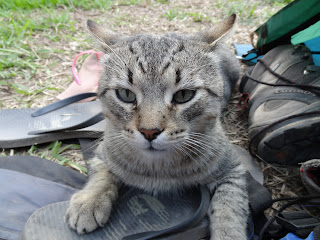Once the capital of the Inca Empire, the city of Cusco is undoubtebly one of the most popular tourist destinations on the whole continent - and that can be pinpointed to one specific area, which features on many a bucket list; the stunning Inca site of Machu Picchu. This was the reason, like so many others, we first wanted to visit South America. My Dad and I had talked of going ourselves after I finished University and he retired, long before I'd even met Dave - so it was always going to be a highlight of our trip. For this reason, we booked the official Inca trail months before (just under a year ago now!). There are so many variations on the trek, and much cheaper ways to get to Machu Picchu itself, but I would do it all again exactly the same way.

So we arrived to the city of Cusco with enough time to acclimatise before embarking on our trek, and explored our surroundings. The city is a maze of steep and narrow streets, lined with cobblestones and littered with Inca foundations mixed with Colonial buildings. The surroundings of the square are lined with original Inca walls. We visited numerous museums, with archaeological finds from all over the country - from ornately carved figurines to anthropomorphic clay pots. We also visited (on recommendation from Gilbs and K-Wottz) a charming chocolate museum, filled with interesting facts and statistics, and here we sampled a delicious chocolate fondue.

We had read about the surrounding archaeological sites, and in one of Padre's book there was a description of how to get a taxi to the furthest one, and walk (about 3 hours) back to the centre. It sounded easy enough, so dodging the price of the tours, and feeling pretty confident after our Colca Canyon exhibition, we set on our way. We taxi-ed to the first site, of Tambomachay, more popularly known as The Baths of the Incas - there are theories connecting the site to an ancient water cult.
From there we walked to the next site of Pukapukara, which is a beautiful ruin of a fortress, or a guard post. It had several lower chambers, a smattering of stone rooms and an upper esplanade which offered stunning vistas.

The next site was a fair walk away, warned the book, about half an hour. After about 15 minutes we were surprised to have seen no other tourists, but assumed we were being awfully clever and everyone else had forked out for a tour. After about an hour, we began to doubt that we were on the right path, having not seen another person, or indeed much of a path, for the last half hour. About three hours later we came across a village with a tourist office, who informed us we had walked in completely the wrong direction, and were in fact now so far off track we were no longer on our map. So this then resulted in us getting a taxi to the final ruin (totally disheartened and so skipping the two inbetween), Sacsaywaman (lovingly called 'Sexywoman' by tourists). This site was by far the most spectacular; considered the most impressive after Machu Picchu. The fort was the site of a bitter battle of the Spanish Conquest, and was used as a base to lay siege to the conquistadors residing in Cusco. It was three tiered forticiations of gigantic stones, a phenomenal site. There is an area known as the Inca Throne, where only the foundations remain, but still to this day there are offerings around the area. The site really was incredible, and got us all quite excited for the ruins we were bound to see on the Inca trail.



So after a day of rest, we were then off on the Inca Trail - a 43km walk over four days which combines inca ruins, jungle paths through cloud forest and high passes (up to 4200m) camping along the way, finally reaching the lost Inca city of Mach Picchu on the fourth day. We were lucky enough to be on the same trek as our friend Aled (who worked in the clinic at Inti Wara Yassi). We were picked up by a bus and taken to the town of Ollantaytambo where we had breakfast, and were given the oppertunity to buy any last minute items - here we purchased trekking poles, and were extremely glad we did! We were then taken to the beginning of our trek, at kilometer 82.


On the first day the trek lasted for about four hours, and we were able to go at our own pace, enjoying the spectacular views of the snow capped Urubamba mountain range. We also had our first glimpse of Inca ruins - those of Llactapata (which was used primarily as an agricultural station). We were amazed that by the time we reached our first stop, the Chaski's (or porters) had already set up a giant tent and prepared a delicious three course meal for us all. The food was exquisite, and continued to be throughout the trek. We spent the evening drinking beers and getting to know each other, and found we were lucky enough to be in a great group of people. 14 of us in total, with 9 Americans - one other girl from Pinner (small world!) bringing the total of Brits to 5.

The second day was one of the most intense work outs of my life - a real physical challenge! The journey to the highest pass was one of beautiful scenery, but the countless steps up to the vista made them partially visible through the sweat. The use of coca leaves again proved invaluble during this part of the trek! We were comforted by knowing it was the most difficult part of the trail, and the elation when reaching the top was plain in everyones faces. The combination of the steep steps and the shortness of breath due to the altitude was exhilirating - I can say that in hindsight!



The journey down to our campsite was more enjoyable, and our knees were grateful for our trekking poles helping to ease our way down the steep steps. The views all around were stunning, including a beautiful waterfall cascading from higher than the eye could see. The third day was an easier walk but a longer day, though it was broken up by Inca ruins across the trail (which was for the most part original Inca stones). The second half of the day was incredible, we walked through the cloud forest on the Inca trail, full of hanging mosses and trails, Inca caves carved into rocks, orchids and general jungle. It was beautiful - and a fantastic birthday for Aled! The cook even made him a special birthday cake to celebrate, we had become a little family. For Aled's birthday meal, and our last meal, we were surprised with a garnish of an intricately carved cucumber Parrott, who we promptly named Benjamin, and became the mascot for our final day.


When we reached the second highest pass of the trek, at 4000m, our guide Manny showed us how his ancestors would have made an offering to Pachamama, mother earth. We each had carried a small stone to the height, and offered it with coca leaves and some scented flower water, making a wish for whatever we desired in our future.
On the fourthand final day, we awoke early and were on the road by 4am. It was quite an intense trek to the Sun Gate (Intipunku), up an almost vertical climb, with other groups overtaking, and some even running to get there. Everyone seemed worried they would miss something amazing, or else not be able to see. However, when we got there we found that there was actually loads of space, and from every angle there was a spectacular view, our first glimpse at the lost city. Here we sat and watched the sun rise over the colossal ruins, and congratulated each other on the monumental hike we had almost completed.



Once we reached the city, we were given a tour by our guide and then were able to explore the site ourselves. The pictures really cannot do it justice - the scale of the ruins is incredible, and to imagine what it would have been like as an Inca city is really magical. The site fills up with tourists extremely quickly, and it is hard not to feel a little resentment towards those who had just popped up on a bus! We then met our tour group for lunch in Aguas Calientes, and a well deserved GIANT beer. Benjamin was celebrated in all of his glory, and put in a zip lock bag for us to take around Peru (NB, he made it as far as Lima where he promptly turned to a bag of stinky mush and was thrown away).





We chose to spend an extra night in the town of Aguas Calientes, with the intentions of going to the natural hot springs while we were there. But instead we ended up drinking into the evening at our hostel, and then meeting three of the guys from the tour for dinner and more drinks, and a lot of laughing. We got the train back to Cusco, which was an experience in itself. We were given food, a surprise visit from a masked dancer, and a fashion show of baby alpaca designs during the journey - entirely bizarre!


The next day Padre has booked us on a day trip white water rafting as a treat. I was pretty nervous, never having done it before, and a bit afraid of bashing my skull against a rock on a rapid. However, it turned out to be BRILLIANT fun, really exhilirating and a good laugh as well. Our team, of all girls except for Dave and Padre, called ourselves the Champions, and survived without anyone going overboard. Well, we all went overboard, but only when pushed by each other! We ended the day by ziplining across the river, and then returned to our hostel. After an adventurous two weeks we parted ways with Padre; having seen and experienced some things which will never be forgotten, and are unlikely to be topped.




















































